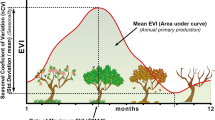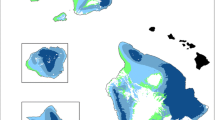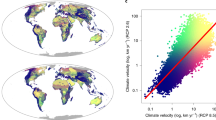Abstract
Context
Conservation of geophysical diversity has been proposed as a strategy for conserving species diversity and facilitating adaptive capacity of species in the face of changing climate. Existing protected areas may not correspond to the most geophysically diverse places because they have typically not been selected on this basis.
Objectives
My objectives were to characterize geophysical diversity in the southwestern United States, assess the sensitivity of my results to methodological choices, and assess the degree to which the existing protected areas network in this region captures geophysically diverse places.
Methods
I classified the region into geophysically distinct units (land facets) on the basis of topographic and edaphic variables. I calculated land facet diversity on the basis of multiple classification methods, thematic resolutions, and spatial scales (i.e., spatial grain and neighborhood size), assessed the sensitivity of land-facet diversity estimates to these methods, and integrated the results to provide a multi-scaled estimate of geophysical diversity. I used gap analysis to assess the proportion of lands with high land-facet diversity that is protected.
Results
Land facet diversity estimates were more sensitive to spatial scale than to methods, but results based on different methods or spatial scales typically were highly correlated. Gaps in the protected areas network include geophysically diverse lands in the Central Basin and Range, Chihuahuan Desert, and Wasatch and Uinta Mountains.
Conclusion
The analytical approach and results from this study can provide perspectives and guidance for identifying and prioritizing locations that may facilitate species’ capacity to adapt to climate change.





Similar content being viewed by others
References
Ackerly DD, Loarie SR, Cornwell WK, Weiss SB, Hamilton H, Branciforte R, Kraft NJB (2010) The geography of climate change: implications for conservation biogeography. Divers Distrib 16(3):476–487
Anderson MG, Ferree CE (2010) Conserving the stage: climate change and the geophysical underpinnings of species diversity. PLoS One 5(7):e11554
Anderson MG, Clark M, Sheldon AO (2014) Estimating climate resilience for conservation across geophysical settings. Conserv Biol 28(4):959–970
Aycrigg JL, Davidson A, Svancara LK, Gergely KJ, McKerrow A, Scott JM (2013) Representation of ecological systems within the protected areas network of the continental United States. PloS One 8(1):e54689
Beier P, Brost B (2010) Use of land facets to plan for climate change: conserving the arenas, not the actors. Conserv Biol 24(3):701–710
Belbin L (1993) Environmental representativeness—regional partitioning and reserve selection. Biol Conserv 66(3):223–230
Brost BM, Beier P (2012) Use of land facets to design linkages for climate change. Ecol Appl 22(1):87–103
Buffo J, Fritschen LJ, Murphy JL (1972) Direct solar radiation on various slopes from 0 to 60 degrees north latitude. USDA Forest Service Research Paper, PNW-142. Portland, OR
Cain ML, Milligan BG, Strand AE (2000) Long-distance dispersal in plant populations. Am J Bot 87(9):1217–1227
Capotorti G, Guida D, Siervo V, Smiraglia D, Blasi C (2012) Ecological classification of land and conservation of biodiversity at the national level: the case of Italy. Biol Conserv 147(1):174–183
Carlson B, Wang D, Capen D, Thompson E (2004) An evaluation of GIS-derived landscape diversity units to guide landscape-level map** of natural communities. J Nat Conserv 12(1):15–23
Clark JS, Fastie C, Hurtt G, Jackson ST, Johnson C, King GA, Lewis M, Lynch J, Pacala S, Prentice C, Schupp EW, Webb T, Wyckoff P (1998) Reid’s Paradox of rapid plant migration: dispersal theory and interpretation of paleoecological records. Bioscience 48(1):13–24
Coblentz DD, Riitters KH (2004) Topographic controls on the regional-scale biodiversity of the south-western USA. J Biogeogr 31(7):1125–1138
Davis EB, Koo MS, Conroy C, Patton JL, Moritz C (2008) The California Hotspots Project: identifying regions of rapid diversification of mammals. Mol Ecol 17(1):120–138
Deng Y, Goodchild MF, Chen X (2009) Using NDVI to define thermal south in several mountainous landscapes of California. Comput Geosci 35:327–336
Dickson BG, Zachmann LJ, Albano CM (2014) Systematic identification of potential conservation priority areas on roadless Bureau of Land Management lands in the western United States. Biol Conserv 178:117–127
Dobrowski SZ (2011) A climatic basis for microrefugia: the influence of terrain on climate. Glob Change Biol 17(2):1022–1035
Dobrowski SZ, Abatzoglou J, Swanson AK, Greenberg JA, Mynsberge AR, Holden AZ, Schwartz MK (2013) The climate velocity of the contiguous United States during the 20th century. Glob Chang Biol 19(1):241–251
EPA (2013) Level III Ecoregions of the Conterminous United States. Corvallis, OR
Faith DP, Walker PA (1996) Environmental diversity: on the best-possible use of surrogate data for assessing the relative biodiversity of sets of areas. Biodivers Conserv 5:399–415
Fine PVA, Daly DC, Munoz GV, Mesones I, Cameron KM (2005) The contribution of edaphic heterogeneity to the evolution and diversity of Burseraceae trees in the western Amazon. Evolution 59(7):1464–1478
Gesch D, Oimoen MS, Greenlee S, Nelson C, Steuck M, Tyler D (2002) The national elevation dataset. Photogram Eng Remote Sens 68:5–32
Gessler PE, Moore ID, McKenzie NJ, Ryan PJ (1995) Soil-landscape modeling and spatial prediction of soil attributes. Int J Geogr Inf Syst 9(4):421–432
Grantham HS, Pressey RL, Wells JA, Beattie AJ (2010) Effectiveness of biodiversity surrogates for conservation planning: different measures of effectiveness generate a kaleidoscope of variation. PLoS One 5(7):e11430
Hampe A, Jump AS (2011) Climate relicts: past, present, future. Annu Rev Ecol Evol Syst 42:313–333
Hermoso V, Januchowski-Hartley SR, Pressey RL (2013) When the suit does not fit biodiversity: loose surrogates compromise the achievement of conservation goals. Biol Conserv 159:197–205
Holden ZA, Jolly MW (2011) Modeling topographic influences on fuel moisture and fire danger in complex terrain to improve wildland fire management decision support. For Ecol Manage 262:2133–2141
Hunter ML, Jacobson GL, Webb T (1988) Paleoecology and the coarse-filter approach to maintaining biological diversity. Conserv Biol 2(4):375–385
Jansson R (2003) Global patterns in endemism explained by past climatic change. Proc R Soc B-Biol Sci 270(1515):583–590
Jenks GF (1967) The data model concept in statistical map**. Int Yearb Cartogr 7:56–59
Jones HG (1992) Plants and microclimate: a quantitative approach to environmental plant physiology. Cambridge University Press, Cambridge
Kartesz J, Farstad A (1999) Multi-scale analysis of endemism of vascular plant species. In: Ricketts TH, Dinerstein E, Olson DM, Loucks C (eds) Terrestrial ecoregions of North America: a conservation assessment. Island Press, Washington, D.C., pp 51–55
Keppel G, Van Niel KP, Wardell-Johnson GW, Yates CJ, Byrne M, Mucina L, Schut AGT, Hopper SD, Franklin SE (2012) Refugia: identifying and understanding safe havens for biodiversity under climate change. Glob Ecol Biogeogr 21(4):393–404
Kinlan BP, Gaines SD (2003) Propagule dispersal in marine and terrestrial environments: a community perspective. Ecology 84(8):2007–2020
Loarie SR, Duffy PB, Hamilton H, Asner GP, Field CB, Ackerly DD (2009) The velocity of climate change. Nature 462(7276):1052 U111
McCune B, Keon D (2002) Equations for potential annual direct incident radiation and heat load. J Veg Sci 13(4):603–606
Miller KR (1982) Parks and protected areas: considerations for the future. Ambio 11(5):315–317
Moore ID, Grayson RB, Ladson AR (1991) Digital terrain modelling: a review of hydrological, geomorphological, and biological applications. Hydrol Process 5:3–30
Murphy DD, Weiss SB (1992) Effects of climate change on biological diversity in Western North America: species losses and mechanisms. In: Peters RL, Lovejoy TE (eds) Global warming and biological diversity. Yale University Press, Castleton
Myers N, Mittermeier RA, Mittermeier CG, da Fonseca GAB, Kent J (2000) Biodiversity hotspots for conservation priorities. Nature 403(6772):853–858
Noss RF, Dobson AP, Baldwin R, Beier P, Davis CR, Dellasalla DA, Francis J, Locke H, Nowak K, Lopez R, Reining C, Trombulak SC, Tabor G (2012) Bolder thinking for conservation. Conserv Biol 26(1):1–4
Ordonez A, Williams JW (2013) Climatic and biotic velocities for woody taxa distributions over the last 16,000 years in eastern North America. Ecol Lett 16:773–781
Pressey RL (1994) Ad Hoc reservations: forward or backward steps in develo** representative reserve systems? Conserv Biol 8(3):662–668
Pressey RL, Bedward M (1991) Map** the environment at different scales: benefits and costs for nature conservation. In: Margules CR, Austin MP (eds) Nature Conservation: cost effective biological surveys and data analysis. CSIRO, Melbourne, pp 7–13
Rajakaruna N (2004) The edaphic factor in the origin of plant species. Int Geol Rev 46(5):471–478
Reyers B, Wessels KJ, van Jaarsveld AS (2002) An assessment of biodiversity surrogacy options in the Limpopo Province of South Africa. Afr Zool 37(2):185–195
Rosenzweig ML (1995) Species diversity in space and time. Cambridge University Press, Cambridge
Sandel B, Arge L, Dalsgaard B, Davies RG, Gaston KJ, Sutherland WJ, Svenning JC (2011) The influence of Late Quaternary climate-change velocity on species endemism. Science 334(6056):660–664
Schaetzl RJ, Krist FJ, Miller BA (2012) A taxonomically based ordinal estimate of soil productivity for landscape-scale analyses. Soil Sci 177(4):288–299
Scherrer D, Körner C (2010) Infra-red thermometry of alpine landscapes challenges climatic warming projections. Glob Change Biol 16(9):2602–2613
Schloss CA, Lawler JJ, Larson ER, Papendick HL, Case MJ, Evans DM, DeLap JH, Langdon JGR, Hall SA, McRae BH (2011) Systematic conservation planning in the face of climate change: bet-hedging on the Columbia Plateau. PloS One 6(12):e28788
Schloss CA, Nunez TA, Lawler JJ (2012) Dispersal will limit ability of mammals to track climate change in the Western Hemisphere. Proc Natl Acad Sci USA 109(22):8606–8611
Scott JM, Davis F, Csuti B, Noss R, Butterfield B, Groves C, Anderson H, Caicco S, D’Erchia F, Edwards Jr TC, Ulliman J, Wright RG (1993) Gap analysis—a geographic approach to protection of biological diversity. Wildl Monogr 123:1–41
Scott JM, Davis FW, McGhie RG, Wright RG, Groves C, Estes J (2001) Nature reserves: do they capture the full range of America’s biological diversity? Ecol Appl 11(4):999–1007
Sears MW, Raskin E, Angilletta MJ Jr (2011) The world is not flat: defining relevant thermal landscapes in the context of climate change. Integr Comp Biol 51(5):666–675
Siefert A, Ravenscroft C, Althoff D, Alvarez-Yépiz JC, Carter BE, Glennon KL, Heberling M, Jo IS, Pontes A, Sauer A, Willis A, Fridley JD (2012) Scale dependence of vegetation-environment relationships: a meta-analysis of multivariate data. J Veg Sci 23(5):942–951
Stamper TJ, Hicke JA, Jennings M, Aycrigg J (2012) Spatial and temporal patterns of changes in protected areas across the Southwestern United States. Biodivers Conserv 22(2):343–356
Tingley MW, Estes LD, Wilcove DS (2013) Climate change must not blow conservation off course. Nature 500:271–272
USDA SSDS (1993) Soil Survey Manual. Handbook 18. Soil Conservation Service, U.S. Dept. of Agriculture
USDA (1999) Soil Taxonomy: a basic system of soil classification for making and interpreting soil surveys. In: Natural Resources Conservation Service (ed), Agriculture Handbook, Number 436
USGS (2011a) National Land Cover, version 2. http://gapanalysis.usgs.gov/data/land-cover-data/. Accessed 18 Feb 2012
USGS (2011b) Protected areas database of the United States (PADUS), version 1.2. http://gapanalysis.usgs.gov/data/padus-data/. Accessed 25 Apr 2012
Van Wynsberge S, Andrefouet S, Hamel MA, Kulbicki M (2012) Habitats as surrogates of taxonomic and functional fish assemblages in coral reef ecosystems: a critical analysis of factors driving effectiveness. PLoS One 7(7):e40997
Wessels KJ, Freitag S, van Jaarsveld AS (1999) The use of land facets as biodiversity surrogates during reserve selection at a local scale. Biol Conserv 89(1):21–38
Wiens JA (1989) Spatial scaling in ecology. Funct Ecol 3(4):385–397
Acknowledgments
Funding for this work was provided by the U. S. Department of the Interior Southwest Climate Science Center. Brett Dickson, Erica Fleishman, Dave Theobald, Mark Schwartz, Paul Beier, and two anonymous reviewers provided thoughtful comments that significantly improved this manuscript.
Author information
Authors and Affiliations
Corresponding author
Rights and permissions
About this article
Cite this article
Albano, C.M. Identification of geophysically diverse locations that may facilitate species’ persistence and adaptation to climate change in the southwestern United States. Landscape Ecol 30, 1023–1037 (2015). https://doi.org/10.1007/s10980-015-0167-7
Received:
Accepted:
Published:
Issue Date:
DOI: https://doi.org/10.1007/s10980-015-0167-7




